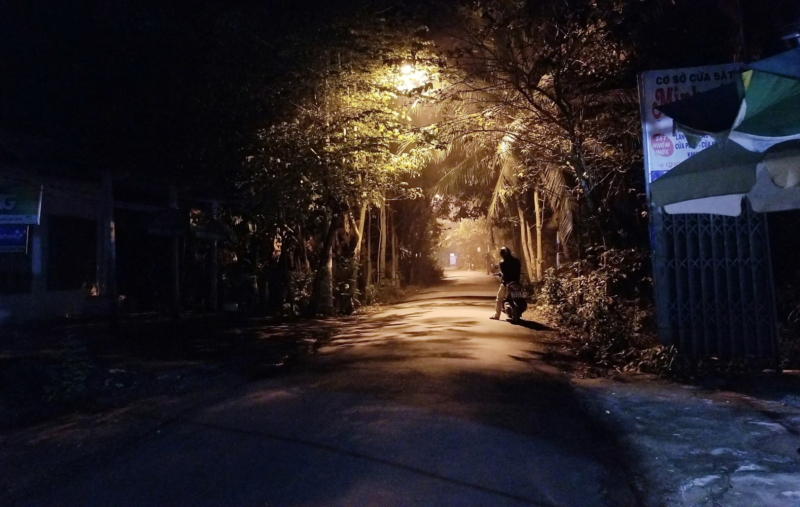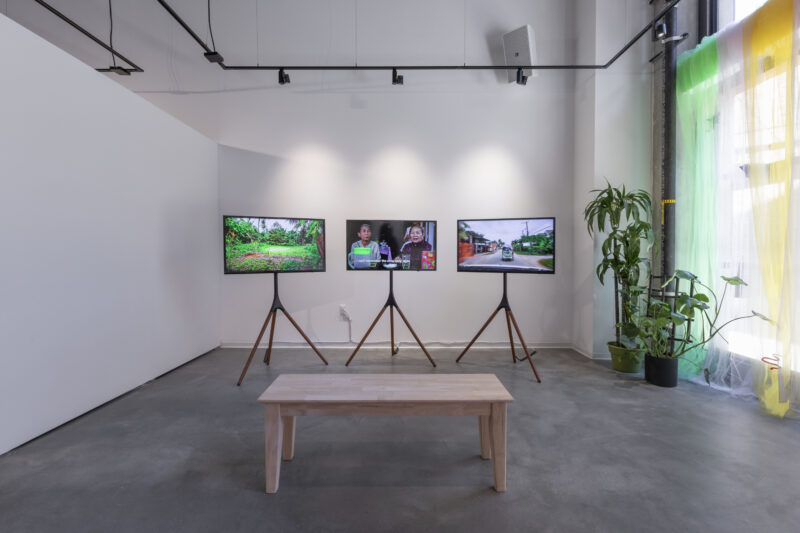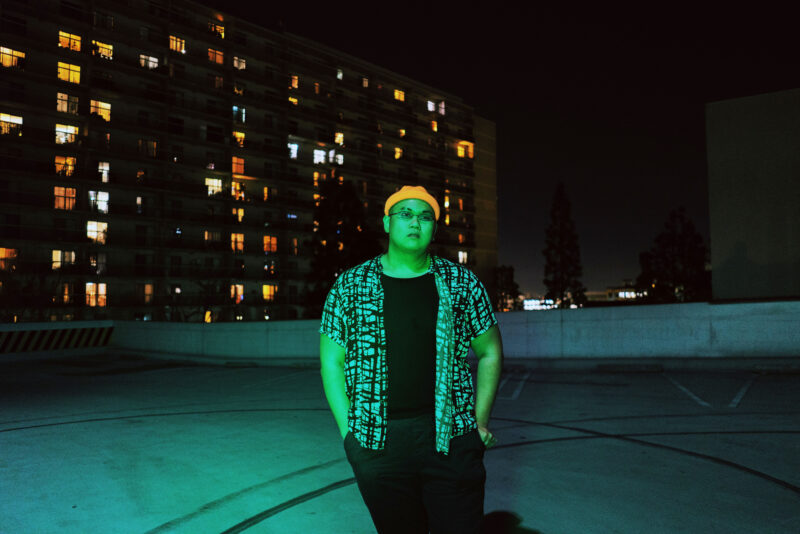one never remembers alone, an exhibition, public programs series, and pedagogical platform, examined the ways memory can be transmitted through generations, both temporally and spatially. The exhibition brought together artists whose work considers the notion that one’s past can be passed on to another. Employing archival and performative interventions in media such as photography, photomontage, video, printmaking, and installation, exhibiting artists jointly activated iterations of memory and formations of kinship, building bridges between themselves and their personal and/or collective lineages. These interventions put forth a visual language that attempts to unravel colonial narratives, convey the varied experience of movement and migration, and imagine an anti-colonial futurity. Participating artists included Amal Amer, Beatriz Cortez, Maria Dumlao, Sebastián Hernandez, Ann Le, Joiri Minaya, Boone Nguyen, and Adee Roberson. The exhibition was on view from January 15- February 2, 2020 at the USC Graduate Gallery in Los Angeles.
I co-curated this exhibition with my cohort members, Loujain Bager, Eve Moeykens-Arballo, Bianca M. Moran, and Joseph Daniel Valencia as part of our practicum for our MA in Curatorial Practices Program in the USC Roski School of Art and Design.
Boone Nguyen is an artist and organizer currently based in Los Angeles. Central to his work are the themes of community, memory, displacement, placemaking, leaving, returning, loss, and transformation. As a war refugee, Nguyen is searching for a “distant, yet familiar homeplace,” primarily through the mediums of photography, video, and multimedia installation. The following essay was originally published in conjunction with the exhibition.
~ ~ ~
There’s something rather unique about music and its relationship with time. For listeners and performers alike, music creates a specific type of temporality: a temporality wherein one is aligned with others. In a chamber music ensemble, often the players signal to one another and breathe together before the piece begins. This breath—the depth, the duration, the physical sensation—is so crucial to beginning the piece together. It must be felt together. Throughout the piece, the players listen intensely to one another, establishing eye contact when necessary, physically moving similarly, so that the timing and shape of the musical phrase, whether pushed, pulled, or stretched, remains consistent and “in control.” The use of”‘in control” here is deliberate, as musicians are intentionally and willfully manipulating the phenomenology of time. Audiences and listeners must buy into this temporality, this pacing, this suspension of —or rather recreation of an alternate— experience of time. As such, the experience of sharing music with others and listening or performing collectively can be viewed as a form of building community.

Boone Nguyen, Landscape Memory, 2019 (still)
Although this notion is relatively universal, it is especially pertinent in the context of the exhibition one never remembers alone. In this way, as well others, music creates a space to remember. It creates a space to be present with one another. It challenges the perceived hegemony of time over human existence, if only for a few moments.
Landscape Memory, a three-channel video installation by artist and organizer Boone Nguyen, explores the complexities of diasporic remembering as Nguyen returns to the rural village where his extended family lives in Vietnam. The video documents and juxtaposes varying ways of remembering and honoring the dead, such as cleaning burial sites and burning incense, with bomb crater-turned-lakes, reclaimed over time by nature, in addition to the act of the journey itself. Throughout these videos he layers natural ambient sounds, intimate conversations, and music. While there were other works in one never remembers alone with audio, the specific clips that Nguyen included in Landscape Memory echoed throughout the gallery space in a way that teased the ears of visitors with dramatic and soaring melodic lines, occasionally drifting in and out of earshot. The way the music layers and intermingles with the other audio channels of Landscape Memory— the low bass rumblings of bus/boat/motorcycle engines, the effervescent yet faint sound of rain, the sharp crow of a rooster, the varied tonalities and emotions of the conversations— exemplifies a structure of memory. Sometimes memories present as clear, sharp, in-focus. Other times, memories are fuzzy, somewhat distant, complicated by other happenings, other images, other stories, sounds, faces, histories. Although music is just one of the layers Nguyen employs here, it creates space and carries memory in rather powerful ways.

The music he carefully weaves throughout the videos are short excerpts from popular contemporary Vietnamese folk music sung at karaoke. The two songs, “Anh Biết Không Anh” by Lưu Ánh Loan and “Người Tình Không Đến,” originally written by Ngan Giang, bring together traditional Vietnamese instruments, such as the dan tranh, with those of a standard lounge music ensemble. The audio clips in Landscape Memory of these two songs were collected from a family member’s party and from the next door neighbor of his relatives in Vietnam, respectively. The framing of these songs as karaoke is key. By situating these karaoke recordings within the context of Landscape Memory, Nguyen is locating karaoke, and more broadly music, as sites for collective memory making and remembering. In these communal suspensions of time, in these open spaces, people have the opportunity to remember (and mourn) more freely.
There’s a certain catharsis inherent in experiencing music and karaoke. When you take the microphone during karaoke, you become the pop star, the center of attention, the main stage performer. With that microphone in hand, it doesn’t matter how good or bad you sound, if you miss the entrance, if your voice cracks or if you miss a note. Rather, what matters is how much you feel the music and by extension how much those around you feel it as well. Karaoke is a place for imagination. Maybe, amongst these lush soundscapes and within the embodied phenomenology of karaoke and music, there’s a place for forgetting. Not necessarily the forgetting of a specific memory or of a broader history, but a temporary forgetting– a temporary loss of inhibitions, of self, of time, of place. Maybe this space of forgetting is where the collective remembering and imagining happens.
Author Bio
 Carlo Tuason is a curator, researcher, and musician based in Los Angeles. His current research explores visual politics through protest art, cultural production, and counter-visuality in Hong Kong’s pro-democracy protests. He’s broadly interested in protest movements, visual culture, and creative resistance in Asia and its diaspora. He produces, performs, and releases alternative R&B music under the stage name Chay Guan.
Carlo Tuason is a curator, researcher, and musician based in Los Angeles. His current research explores visual politics through protest art, cultural production, and counter-visuality in Hong Kong’s pro-democracy protests. He’s broadly interested in protest movements, visual culture, and creative resistance in Asia and its diaspora. He produces, performs, and releases alternative R&B music under the stage name Chay Guan.
Do you enjoy reading diaCRITICS? Then please consider subscribing, donating, following us on Instagram or Twitter, and sharing this post to your social networks. You can also join the conversation by leaving a comment!


